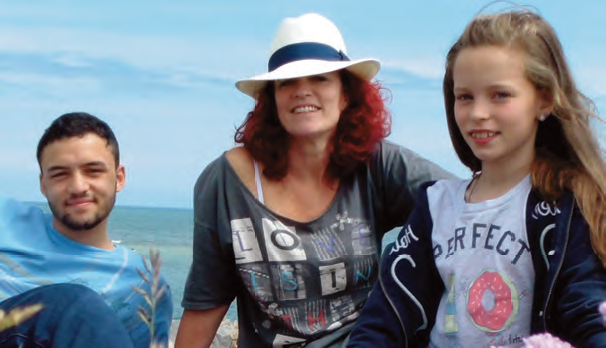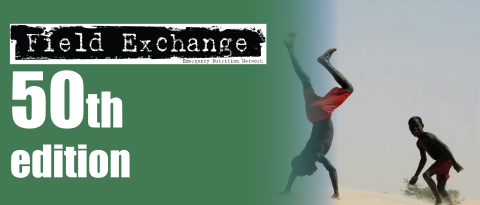What became of …………Fiona O’Reilly?
 Dear ENN,
Dear ENN,
Congratulations on your 50th issue of Field Exchange!
It seems like yesterday when Jeremy and I were putting together the very first issue of Field Exchange. Killian Forde, who ‘helped out’ long enough to make himself invaluable and guilt us into paying him a pittance, reminded me of how I manically upskilled myself to produce the inaugural issue. Thankfully, my dabble in production design ended when the brilliant Kornelius Elstner joined the team (Issue 6); he took on this role and greatly improved the design. Unfortunately Killian’s ‘What became of …’ column, which dug up old has-beens such as Michael Buerk (Issue 2, page 22) and had me door stepping Bob Geldof (slightly embarrassing as he declined an interview) didn’t survive the test of time! I’m not sure how I feel about appearing now as an ‘old has-been’ myself!
How Field Exchange looked was very important to me as I would argue “no one will pick it up if it doesn’t look good”. I’m delighted to see that the design, under the creative hand of Orna O’Reilly, has been enhanced over time to reflect in visual terms the ENNs vision for professionalism, quality and accessibility. The website too has continued the attractive style and developed into one of the best examples of a web based portal and repository for learning and exchange. It’s clear, simple, easy to navigate and attractive.
Initially and understandably when the publication was not well established, we had to put much work into ‘stimulating’ the production of articles. In practice, this meant hounding people to write about what they were doing and travelling to places where there were significant humanitarian food and nutrition interventions. One such place was Lokichogio, on the border of Kenya and South Sudan. The year was 1999 and my son Kern was 5 years old. I flew to the then humanitarian hotspot with him in tow to generate material for Field Exchange. Again, with my belief the photos were every bit as important as text, I asked a Turkana woman (from the local area) if she would pose for a photo that I could use in the publication. To my surprise, she refused. I was curious. She told me about her belief that my camera, if pointed at her, would take her soul. I reassured her by suggesting that my son would pose beside her. I would hardly steal my son’s soul so she was safe, I reasoned. This worked and the result can be seen in Issue 6, page 10. However, my clever negotiation backfired on me in the years to come when, to defend himself from my reprimands or disapproval, my son would say, “What do you expect? You took my soul with your camera in Lokichogio.”
Not only in aesthetics and accessibility, but every aspect of the ENN and Field Exchange appears to have developed. I recall that for a while before I left (Issue 20 was my last issue), I was mildly concerned that the increasing standard of the publication might follow other high-browed academic publications and risk excluding the less experienced/specialised; those like myself as a field worker, who did not have a nutrition degree and who wouldn’t recognise a Z score if it hit them in the face. Getting the balance between accessibility and specialisation can be difficult. However, it’s a balance that Field Exchange together with Nutrition Exchange achieves beautifully.
In my view, the ENN and Field Exchange have gone far beyond the original aim to strengthen institutional memory in the area of food and nutrition in emergencies. The ENN has also broken new ground in the area, through research and development and thus improved practice.
I can still recall the years pre-ENN, when best practice guides and research was either in short supply or hard to find from the field. I recall in the early nineties working in the Somali refugee camp in Hartisheik, Ethiopia and later in war torn Mogadishu. I, like others working in humanitarian crisis, was at a loss to know what to do with infants who didn’t have breastfeeding as an option. The ENN provided an opportunity to tackle infant feeding in a practical and nutritionally sound way, which hitherto had not been done amidst a politically charged environment where infant formula could not be mentioned for fear it would undermine breastfeeding, yet homemade recipes were simply inadequate. The infant feeding group, with critical involvement from the WHO, IBFAN, UNICEF & Linkages, was established and the real and difficult problems that emergencies threw up began to be tackled. I’m delighted to see the huge developments in this area continue under the coordination of the ENN. This is just one of many areas in which developments were facilitated by the ENN.
While my career has taken me on a different path, I occasionally travel to Africa to undertake research or evaluations and immediately reach for Field Exchange and ENN online if my work in anyway touches on the theme of food or nutrition. I always have a peep at ‘People in Aid’ on the back page to see who’s still around and check out the witty Panda cartoon still contributed by Jon Berkeley each month.
Looking back, I fondly and proudly remember the early days of establishing the ENN and producing Field Exchange with Jeremy, Killian and Kornelius. Deirdre Handy, the beady eyed proof reader since the early issues, remains on the editorial team scrutinising every word. However we (the ENN formal team) could not have done it and it would not have worked if it had not developed as a collaborative effort. As it said in the first editorial, “it’s yours and ours”. In the early days of the ENN, a number of committed individuals got involved, keen to make a difference and share learning through experience; they helped to make it happen and deserve a mention. Those who spring to mind are Lola Gostelow, Anna Taylor, Saskia van der Kam, Rita Bhatia, Helen Young, Marion Kelly, Annalies Borel, Mike Golden and Yvonne Grellety (sorry to those not mentioned.. the aging brain and all that). Of course, Prof John Kevany was invaluable in providing an institutional base at Trinity College in Dublin and general wisdom. The foresight of Irish Aid, our first institutional funder, has to be noted too, with their strategy to make us get matched funding for their contribution from other organisations and donors. This strategy meant a broad base of ownership and involvement.
I congratulate Marie who I handed over to, Jeremy who has been the back bone since the beginning and the rest of the team in improving and developing the ENN and Field Exchange. Now I have broken an editorial rule of mine – to be brief!
Happy 50th Field Exchange and I wish you 50 more at least!
Fiona O’Reilly
Fiona was the first Co-Editor and Co-Director of ENN from 1997-2004.
Dr Fiona O’Reilly is a Social Scientist currently working as a Senior Research Fellow for the Partnership for Health Equity based at University Limerick and the North Dublin City GP Training Programme in Dublin, Ireland. She is also the Director of Kernena Consulting.


